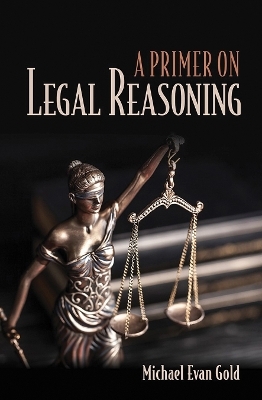
A Primer on Legal Reasoning
Ilr Press (Verlag)
978-1-5017-3027-6 (ISBN)
After years of teaching law courses to undergraduate, graduate, and law students, Michael Evan Gold has come to believe that the traditional way of teaching – analysis, explanation, and example – is superior to the Socratic Method for students at the outset of their studies.
In courses taught Socratically, even the most gifted students can struggle, and many others are lost in a fog for months. Gold offers a meta approach to teaching legal reasoning, bringing the process of argumentation to the fore.
Using examples both from the law and from daily life, Gold's book will help undergraduates and first-year law students to understand legal discourse. The book analyzes and illustrates the principles of legal reasoning, such as logical deduction, analogies and distinctions, and application of law to fact, and even solves the mystery of how to spot an issue.
In Gold's experience, students who understand the principles of analytical thinking are able to understand arguments, to evaluate and reply to them, and ultimately to construct sound arguments of their own.
Michael Evan Gold holds a BA from the University of California at Berkeley and a JD from the Stanford Law School. He is presently Associate Professor of Labor Relations, Law, and History in the ILR School at Cornell University. He is the author of A Dialogue on Comparable Worth, An Introduction to Labor Law, and An Introduction to the Law of Employment Discrimination.
Introduction
1. Issues
I. Definitions
II. Creation of Issues
III. Resolution of Issues
A. Frame the Issue in the Dispute
B. Find the Facts That Pertain to the Issue
C. Identify and Interpret, or if Necessary Create, theAuthority That Governs the Issue
D. Apply Law to Fact (i.e. use the authority to determine the legal consequences of the facts of the dispute)
IV. Identifying Issues
A. Identifying Issues in Documents
The College Daily
When Is an Offer Accepted?
B. Identifying Issues in Facts
The Coconut Cases
V. Review
Sally's Case
The Case of the Research Papers
VI. References
2. Identifying the Governing Rule of Law
I. Definition of a Rule of Law
II. Identifying an Existing Rule of Law
Using Precedents
Identifying the Governing Rule of Law Using Authoritative Texts
Two Cases of Second Thoughts
Diallo's Case
Niner's Case
Packard Motor Car Company
III. Review
IV. References
3. Levels of Abstraction
I. Levels of Abstraction: The Basic Idea
II. The Definition of "Level of Abstraction"
A. Unrelated Issues and Levels of Abstraction
B. Related Issues and Levels of Abstraction
Ben and Gerrie's Case
III. Why the Level of Abstraction Matters
Guenevere v. Arthur
IV. Review
Mary's Case
Wimp v. Bully
The Spat
V. References
4. Deduction
I. In General
A. Syllogisms
B. Enthymemes
II. Categorical Syllogisms and Quasi Syllogisms
A. The Major and Minor Premises Are Affirmative
1. The Valid Form
2. The Fallacy of the Undistributed Middle
B. The Major Premise Is Affirmative and the Minor Premise Is Negative
1. The Valid Form
2. The Fallacy of the Illicit Major
III. Hypothetical Syllogisms
A. Modus Ponens
1. The Valid Form
2. The Fallacy of Denying the Antecedent
B. Modus Tollens
1. The Valid Form
2. The Fallacy of Affirming the Consequent
IV. The Soundness of Syllogisms
V. Moral Syllogisms and Legal Syllogisms
A. Moral Syllogisms
B. Legal Syllogisms
Willie Sutton's Case
VI. The Value of Syllogisms
VII. Review
5. Induction
I. Inductive Generalizations
A. The Nature of Induction
B. Probability of Conclusions
C. Analysis of Arguments in the Form of InductiveGeneralization
D. Some Errors Associated with Inductive Generalization
1. Hasty Generalization
2. Unrepresentative Sample
3. Vivid Counterexample
4. Argument Ad Hominem
5. Post Hoc Ergo Propter Hoc
6. Failure to Falsify Alternative Hypotheses
Excerpt from the Phaedo by Plato
II. Statistical Syllogisms
A. The Nature of a Statistical Syllogism
B. The Force of a Statistical Syllogism
C. Statistical Syllogisms in Ordinary Speech
III. Practical Syllogisms
IV. Review
V. References
6. Arguments in General
I. Definition of an Argument
II. Elements of an Argument
Should Use of Marijuana Be Legal?
Katzenjammer for Congress
III. Recognizing Arguments
IV. Incomplete Arguments
V. Issues, Arguments, and Rhetoric
VI. Review
7. Arguments Classified by Function
I. Arguments as to the Issue in a Case
Clinics v. Hospitals
II. Arguments as to the Facts
III. Arguments as to the Law
A. Arguments as to Which Authority Governs the Case
Here v. There
Round v. About
B. Arguments as to How to Interpret the Governing Authority
Scarpia v. Sky
Puss v. Boots
IV. Arguments Applying Law to Fact
Don Juan in Hell
V. Review
Jefferson Standard Broadcasting Company
VI. References
8. Arguments Based on Evidence
I. Varieties of Evidence
II. Uses of Evidence
9. Policy Arguments
I. The Nature of Policy Arguments
A. Normative Claims
1. Values
2. Varieties of Arguments about Values
3. Sources of Values
B. Assertions of Fact
1. Retrospective and Prospective Facts
2. Sources of Assertions of Fact
II. Uses of Policy Arguments
Lockouts
Employees or Independent Contractors?
III. Evaluating Policy Arguments
The Case of the Bargaining Order
IV. Review
V. References
10. Doctrinal Arguments
I. Varieties of Authority
A. Binding Authorities
B. Advisory Authorities
II. Uses of Authority
People v. Ledfoot
III. Varieties of Doctrinal Argument
IV. Review
Sure-Tan v. National Labor Relations Board
V. References
11. Analogies and Precedents: The Structure and Criteria for Evaluation of Legal Analogies
I. Analogies, Similes, and Metaphors
A. The Nature of Analogies
B. The Danger of Analogies
Aspasia
II. The Legal Analogy
A. Differences between an Ordinary Analogy and a Legal Analogy
B. The Structure of a Legal Analogy
The Captain's Analogy
C. Truncated Analogies
1. Failure to Demonstrate That the Facts of the Precedent Are Similar to the Facts of the Case at Bar
The Case of Illegal Questions
The "Phantom Analogy"
The Seat Belt Cases
2. Failure to Demonstrate That the Rationale
Church of the Holy Trinity v. United States
The Case of Gay Marriage
3. Legal Citations as Truncated Analogies
The Case of the Second Bite
D. The Uses of Analogies
1. Using an Analogy to Identify the Issue
Ford Motor Company v. National Labor Relations Board
Relations Board
2. Using an Analogy to Find the Facts
3. Using an Analogy to Identify and Interpret the Governing Rule of Law
The Taggers' Cases
4. Using an Analogy to Apply Law to Fact
Ford Motor Company v. National Labor Relations Board (continued)
E. Four Criteria for Evaluating Analogies
1. The Precedent Must Be Authoritative; If the Precedent Can Be Vitiated, the Analogy Fails
2. The Legally Significant Facts of the Precedent and the Case at Bar Must Be Analogous in the Important Ways; If the Case at Bar Can Be Distinguished from the Precedent (that is, if the legally significant facts of the case at bar and the precedentdiffer), the Analogy Fails
3. The Analogy Must Be Relevant to the Issue at Hand
4. No Other Analogy May Be More Convincing
Thomas the Mover
III. Review
The Fine Print Cases
References
12. Distinctions: Distinguishing Precedents, Disanalogies, and Precedents and Levels of Abstraction
The Musician's Case
I. The Elements of a Distinction
A. Difference(s) of Fact between the Precedent and the Case at Bar
B. The Importance of the Difference(s) of Fact
1. Some Differences Do Not Matter
Seth's Case: An Unsuccessful Distinction
2. Merely Identifying Difference(s) of Fact Does Not Distinguish a Precedent from a Case at Bar: The Importance of the Difference(s)of Fact Must Be Explained
A Brick and a Rose Petal
Daniela's Case: A Successful Distinction
Seymour's Case
C. The Conclusion
II. The Uses of Distinctions
III. Disanalogies
IV. Distinctions and Levels of Abstraction
V. Seymour's Case Expanded
Shady Sam v. Esme
Seymour v. Hard Luck Hank
VI. Review
The War between the Unions
The Case of the Supervisor's Questions
Young Tom's Case
The Fine Print Cases
13. Holding and Dictum
I. Definitions
II. Effect of a Holding
III. The Scope or Meaning of a Holding
Union Access to Company Property
IV. References
14. Reductios ad Absurdum
I. The Elements of a Reductio ad Absurdum
The Paradox of the Arrow
The Paradox of Achilles and the Tortoise
The Paradox of the Minimum Wage
II. The Criteria of a Sound Reductio ad Absurdum
III. Reductios ad Absurdum in Law
A. Reductios and Precedents
B. Reductios and Fact Finding
The Philosopher's Reductio
C. Reductios and Policy Arguments
IV. Review
V. References
15. Subjective and Objective Standards
I. Standards
II. Subjective Standards
III. Objective Standards
IV. Mixed Standards and Evidence
V. Subjective versus Objective Standards
The One-Year Misunderstanding
VI. Review
The House of Tantalus
16. Interpreting Statutes
I. Sources
A. Text of the Statute
B. Purpose of the Statute
C. Legislative History of the Statute
D. Scholarly Publications
E. Public Policy
Cannery Row
F. Administrative Interpretations
G. Precedent
II. Principles
A. The Principle of Meaningfulness
Duplex v. Deering
B. The Principle of Wholeness
1. Within One Statute
2. Between Statutes
III. The Effect of Precedents on the Meaning of Statutes
IV. References
17. Prima Facie Case, Affi rmative Defense, Burden of Proof
I. Prima Facie Case
A. The Basic Idea
B. Two Meanings of "Prima Facie Case"
Proving Battery
II. Defenses
A. Destruction of the Plaintiff's Prima Facie Case
B. Affirmative Defense
III. Burden of Proof
A. Burden of Persuasion
1. Who Carries the Burden of Persuasion?
2. How Heavy Is the Burden of Persuasion?
3. What Happens If a Party Fails to Carry the Burden of Persuasion?
B. Burden of Production
IV. Prima Facie Case + Affirmative Defense = Rule of Law
V. Review
Battery on a Barstool
The Two-Timer
VI. References
18. Application of Law to Fact
I. Application of Law to Fact Operates Issue by Issue
The Raid
II. Direct Application of Law to Fact
A. Direct Application of Law to Fact by Force of Logic
Caroline's Case
Tommy's Case
B. Direct Application of Law to Fact by Use of Judgment
The Coach
Adora's Case
Amanda's Case
Ben-El's Case
III. Application of Law to Fact Using Precedent
A. Application of Law to Fact Using Binding Precedents
The Honor Society Cases
Harry the Harrier
B. Application of Law to Fact Using Guiding Precedents
The Battle of the Sexes
IV. Review
Dipaboli's Case
V. References
19. A Model of Legal Argument
I. Neither a Quasi Syllogism nor a Statistical Syllogism Can Capture a Legal Argument
Shimul's Case
II. A Model of Legal Argument
A. Toulmin's Model
B. Our Revision of Toulmin's Model
1. Issues as to the Issue
Janus v. American Federation of State, County, and Municipal Employees
2. Issues of Fact
3. Issues of Law
4. Issues of Application of Law to Fact
III. The Value of the Model
IV. Review
V. References
Answers
| Erscheinungsdatum | 05.10.2018 |
|---|---|
| Zusatzinfo | 11 Charts |
| Verlagsort | New York |
| Sprache | englisch |
| Maße | 152 x 229 mm |
| Gewicht | 907 g |
| Themenwelt | Recht / Steuern ► Allgemeines / Lexika |
| Recht / Steuern ► EU / Internationales Recht | |
| ISBN-10 | 1-5017-3027-4 / 1501730274 |
| ISBN-13 | 978-1-5017-3027-6 / 9781501730276 |
| Zustand | Neuware |
| Haben Sie eine Frage zum Produkt? |
aus dem Bereich


